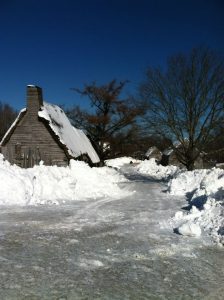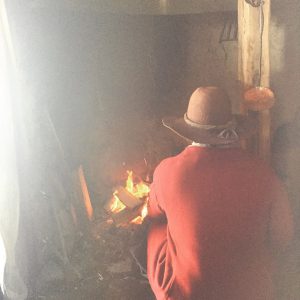
One thing that we can all agree on is that New England weather always keeps us guessing! In a matter of days, the Boston area saw a “bomb-cyclone” drop over a foot of snow, lower than normal temperatures for consecutive days, as well as a stretch of 60-degree weather. As we celebrate a new year, I’m beginning to wonder about the weather conditions when the Mayflower passengers landed. What did they encounter? What did they expect?
We know that the passengers were not prepared for the New England weather, as many perished during the first winter (nearly half died). I am brought to Edward Winslow’s Good Newes from New England,[1] where in 1623 he states:
for the temperature of the air, in almost three years’ experience I can scarce distinguish New England from Old England, in respect to heat and cold, frost, snow rain, winds, &c. Some object, because our Plantation lieth in the latitude of 42 degrees, it must needs be much hotter. I confess I cannot give the reason of the contrary; only experience teacheth us, that if it do not exceed England, it is so little must require better judgements to discern it.
 And for winter, I rather think (if there be difference) it is both sharper and longer in New England than Old; and yet the want of those comforts in the one, which I have enjoyed in the other, may deceive my judgement also. But in my best observation, comparing our own condition with the Relations of other parts of America, I cannot conceive of any to agree better with the constitution of the England, not being oppressed with extremity of heat, nor nipped by biting cold; by which means, blessed be God, we enjoy our health, notwithstanding those difficulties we have undergone, in such a measure as would have been admired if we had lived in England with the like means. The day is two hours longer than here, when it is at the shortest, and as much shorter there, when it is at the longest.”
And for winter, I rather think (if there be difference) it is both sharper and longer in New England than Old; and yet the want of those comforts in the one, which I have enjoyed in the other, may deceive my judgement also. But in my best observation, comparing our own condition with the Relations of other parts of America, I cannot conceive of any to agree better with the constitution of the England, not being oppressed with extremity of heat, nor nipped by biting cold; by which means, blessed be God, we enjoy our health, notwithstanding those difficulties we have undergone, in such a measure as would have been admired if we had lived in England with the like means. The day is two hours longer than here, when it is at the shortest, and as much shorter there, when it is at the longest.”
As we gain more minutes of daylight in Boston and we approach the four-hundredth anniversary of the Mayflower landing in Plymouth, I wonder: Why were the passengers not prepared for the winter cold? The comparison that Winslow makes of Old England and New England may refer to the assumption that the weather would be similar at the same latitudinal level and thus, when arriving in November/December, did they expect Old England winter weather and not the harsh winter that we are all familiar with now?
As for myself, I don’t know where I would be without floor-length parkas, mittens, and wool hats this winter.
Note
[1] Edward Winslow, Good Newes from New England, https://archive.org/details/goodnewesfromnew00wins.
Sarah, your photo of the plantation with snow certainly illustrates the difficulties in 1620 and 2017! Very timely!
The first winter (1620) was brutal for the Pilgrims. My ancestor, Thomas Rogers, who was age 49 or 50, didn’t make it. I cannot imagine that their housing was adequate for the winter weather that first year, and I suspect they made improvements as soon as they could. Nevertheless, one wonders what they used for insulation, and whether they brought enough or could make woolen clothing and bedding. I’m sure there were many “three dog nights”!
From one frozen New Englander to another – Nothing to do with our forefathers, but Overland.com has the warmest sheepskin mittens and gloves. They keep me warmer than anything else ever.
Grateful for the 51 who survived. As a descendant of William Bradford and a Worcester native now in “sunny” CA -a misnomer, I remember well the brutal winters but as a child thought they were oh, so fun.
At -20F, I sleep with two comforters, and two towel-covered bricks at the foot of the bed. My house is small, and so is my stove, so when it is that much below zero (as it has been this year, I dress in several layers, and wear a pair of wool gloves inside my sheepskin mitts (locally made) when I do outside chores. I thought a lot during this unexpected winter about how my 16th century ancestors fared. It must have been deeply frightening, especially as loved ones died all around them.
I cannot help but believe that the native peoples took pity on these forlorn newcomers, and aided them. Still, as soon as they could, the newcomers pulled away from Native ways and emphasized their British background, though adapting it to their new conditions. I think that overall, they might have been better-off to have adapted more to the Native way of doing things. I wonder sometimes how different the outcome might have been, both in the short term and the long.
They never heard of the Gulf Stream which explains a lot of the difference.
Good point! Here is a fun article from the Nantucket Historical Association’s website about how a very famous man in American history helped name the Gulf Stream and disseminate information about it….but nearly 150 years too late for the Pilgrims. https://www.nha.org/library/hn/HN-v44n2-gulfstream.htm